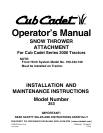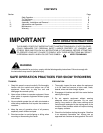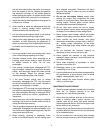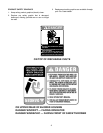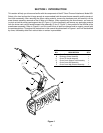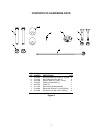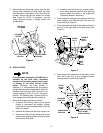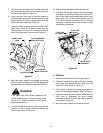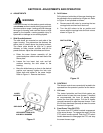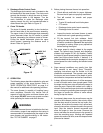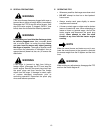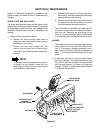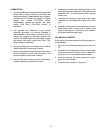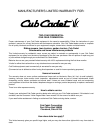3
the fuel tank indoors while the engine is running or
while the engine is still hot. Replace the gasoline
cap securely and wipe off any spilled gasoline
before starting the engine. An ignition spark or heat
may ignite spilled fuel, causing a fire or explosion.
5. Adjust the collector housing height to clear gravel or
crushed rock surfaces.
6. Never attempt to make any adjustments while the
engine is running (except where specifically
recommended by the manufacturer).
7. Let the engine and machine adjust to the outdoor
temperature before starting to clear snow.
8. Always wear safety glasses or eye shields during
operation, or while performing an adjustment or
repair, to protect eyes from foreign objects that may
be thrown from the machine in any direction.
OPERATION
1. Do not put hands or feet near rotating parts. Keep
clear of the discharge opening at all times.
2. Exercise extreme caution when operating on, or
crossing, gravel drives, walks or roads. Stay alert
for hidden hazards or traffic. Do not carry
passengers.
3. After striking a foreign object, disengage the PTO,
stop the engine, remove the wire(s) from the spark
plug(s), and thoroughly inspect the snow thrower
for any damage. Repair the damage before
restarting and operating the snow thrower.
4. If the snow thrower should start to vibrate
abnormally, disengage the PTO, stop the engine
and check immediately for the causes. Vibration is
generally a warning sign of trouble.
5. Disengage the PTO and stop the engine whenever
you leave the operating position, before unclogging
the collector/impeller housing or discharge chute,
and before making any repairs, adjustments or
inspections.
6. Never place your hand in the discharge or collector
openings. Use a stick or wooden broom handle to
unclog the discharge opening.
7. Take all possible precautions when leaving the unit
unattended. Disengage the collector/impeller, shift
into neutral and engage the parking brake, stop the
engine and remove the key.
8. When cleaning, repairing or inspecting, make
certain the collector/impeller and all moving parts
have stopped completely. Disconnect the spark
plug wire and keep it away from plug to prevent
accidental starting.
9. Do not run the engine indoors except when
starting the engine and transporting the snow
thrower in or out of the building. Open doors prior to
starting engine. Exhaust gases contain carbon
monoxide and are extremely dangerous.
10. Do not clear snow across the face of slopes.
Exercise extreme caution when changing direction
on slopes. Do not attempt to clear steep slopes.
11. Never operate snow thrower without all guards,
plates or other safety protection devices in place.
12. Never operate the snow thrower near glass
enclosures, automobiles, window wells, a drop off,
etc., without proper adjustments of the snow
thrower discharge angle. Keep children and pets
away.
13. Do not overload the machine capacity by
attempting to clear snow at too fast a rate.
14. Never operate the machine at high transport
speeds on slippery surfaces. Look behind and use
care when backing up.
15. Never direct discharge at bystanders or allow
anyone in front of the unit.
16. Disengage power to the collector/impeller when
transporting or not in use.
17. Use only attachments and accessories approved by
the manufacturer of snow thrower (such as wheel
weights, counterweights, cabs, etc.).
18. Never operate the snow thrower without good
visibily or artificial light.
MAINTENANCE AND STORAGE
1. Check for proper tightness of shear bolts, mounting
bolts, etc., at frequent intervals to be sure
equipment is in safe working condition.
2. Never store the machine, with fuel in the fuel tank,
inside a building where ignition sources are
present, such as hot water and space heaters,
clothes dryers and the like. Allow the engine to cool
before storing in any enclosure.
3. Always refer to the Owner’s Manual instructions for
important details if the snow thrower is to be stored
for an extended period.
4. Run the machine for a few minutes after throwing
snow to prevent freeze up of the collector/impeller.



